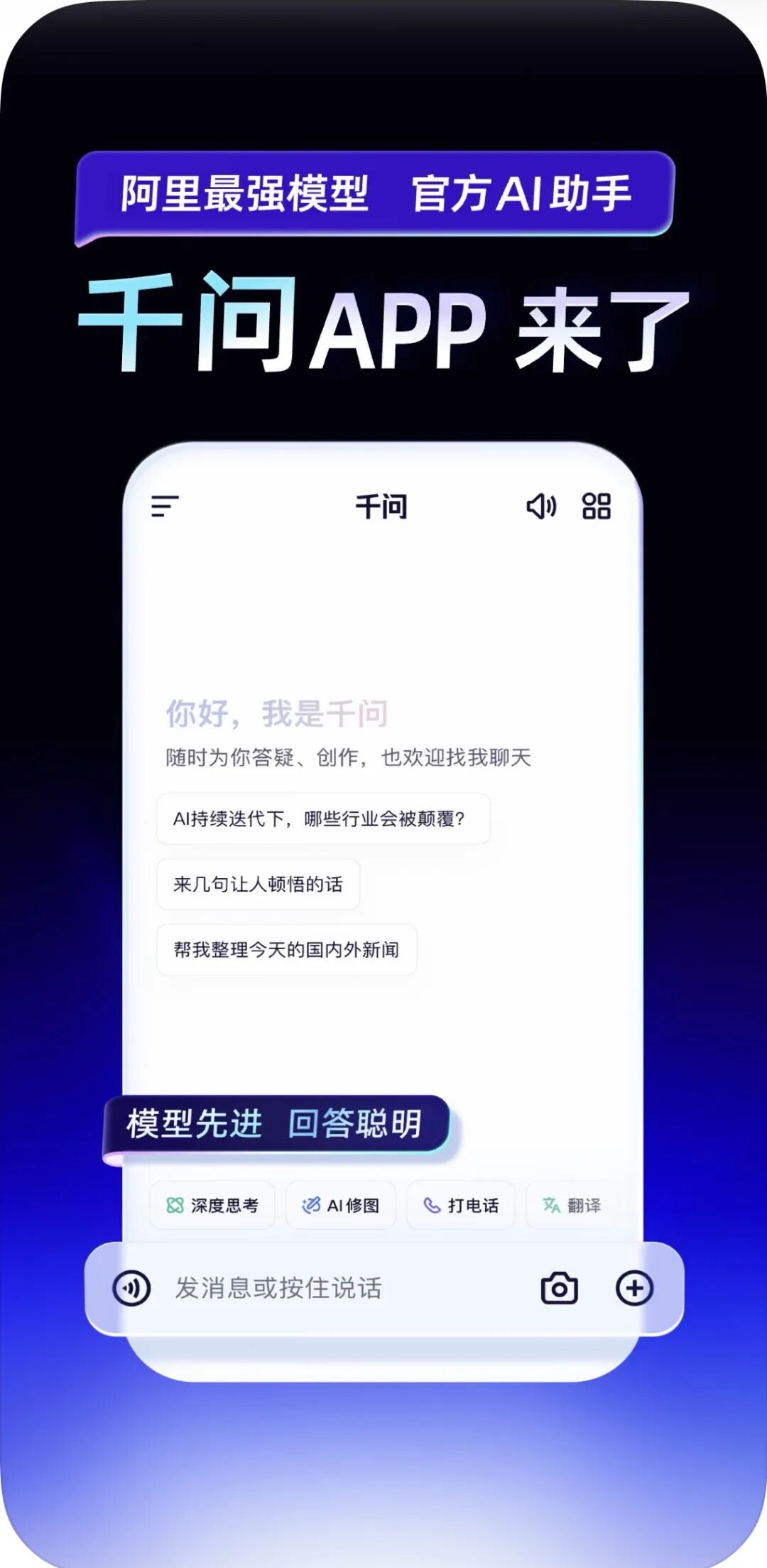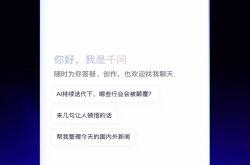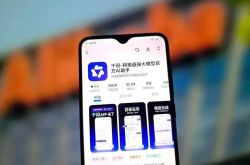Is Quark Being Pushed into an 'Either-Or' Dilemma by Alibaba?
![]() 11/19 2025
11/19 2025
![]() 403
403
© Produced by Digital Light Years (ID: shuziguangnian) | Author Chen Shi | Editor Shao Yang
Alibaba's AI-to-consumer (AI TO C) strategy, which has evolved from Tongyi Qianwen to Tongyi and now to Qianwen, is finally showing signs of clarity after some fluctuations.
Recently, the public beta version of the newly renamed Qianwen App, touted as 'Alibaba's most powerful official AI assistant with large models,' was officially launched. This app, which was rebranded from the Tongyi App (previously known as Tongyi Qianwen), marks a significant step in Alibaba's AI journey.

The app details of Qianwen in the application store indicate that it leverages Alibaba's most advanced closed-source Qwen large model, serving as the primary gateway for users to experience this powerful technology.
Alibaba representatives have stated in media interviews that the company will focus its AI super entry point efforts on Qianwen.
Previously, Alibaba leveraged Alibaba Cloud and the Qwen large model to aggressively pursue AI infrastructure for the business-to-business (B2B) sector. This led to a noticeable 'imbalance' in Alibaba's AI strategy, with significant gaps in consumer-facing (C-end) applications.
Although Tongyi Qianwen, representing Alibaba's native AI applications, was launched as early as September 2023, it has struggled to gain significant traction and has remained relatively lukewarm in the market.
In comparison, ChatGPT boasts over 700 million monthly active users (MAUs), while Doubao and DeepSeek have both surpassed 100 million MAUs. The latest statistics reveal that Tongyi (renamed from Tongyi Qianwen) has just over 3 million MAUs, highlighting its lagging performance.
Clearly, the data performance of the Tongyi App falls far short of what would be expected from a strategic AI application for Alibaba.
Within and outside of Alibaba, Quark, which originated from search, has gained more prominence.
In the first half of this year, Quark made a series of bold moves, launching the Super Frame, a college entrance exam volunteer large model, an AI creation platform, AI glasses, an AI chat assistant, and more. These initiatives signal Quark's ambition to become Alibaba's flagship AI application and the super entry point in the AI era.
However, with the arrival of Qianwen, which carries Alibaba's AI TO C strategic ambitions and enjoys a seemingly higher strategic positioning, richer resource advantages, and greater expectations, Quark now finds itself in an 'either-or' situation.
Alibaba's AI Realignment: Qianwen Seeks 'Unification,' Quark Faces Challenges?
Qianwen and Quark share a common heritage but have distinct paths.
Quark, launched in October 2016, is a browser product incubated by the original Alibaba Mobile Business Group's UC team. For a long time after its launch, Quark, along with UC and others, was part of Alibaba's Digital Media and Entertainment Group.
In 2019, Quark was integrated into Alibaba's newly established Innovation Business Group, marking a significant divergence in its trajectory. Despite several adjustments to the structure of Alibaba's innovative businesses over the years, Quark has consistently been regarded as a key pillar in Alibaba's exploration of innovative businesses.
In November 2023, Alibaba announced its first batch of four strategic innovative businesses, including Quark, further elevating Quark's strategic significance. Since then, Quark has been on an upward trajectory, particularly in terms of data performance.
On the other hand, Tongyi Qianwen originally belonged to Alibaba Cloud and served as the core foundation of Alibaba's artificial intelligence large models. At the end of last year, Alibaba transferred the Tongyi To C product application team to the Alibaba Intelligent Information Business Group, separating the underlying technology of 'Tongyi' from its product applications.
Thus, Tongyi and Quark officially came under the umbrella of the Alibaba Intelligent Information Business Group. Although both utilize Alibaba's Qwen large model, Alibaba has different positioning for Quark and Qianwen.
In terms of status, Qianwen is Alibaba's native AI application for the Qwen large model, while Quark represents the AI-ization of Alibaba's search business, with many of its functional applications being AI-powered tools derived from the Qwen large model's technological foundation.
According to public reports, although the new Qianwen project falls under the Alibaba Intelligent Information Business Group, its overall coordination is currently led by the Alibaba Group level, with the renaming and launch personally approved by Alibaba Group CEO Wu Yongming.
From Alibaba's core management perspective, the renaming and launch of the Qianwen App represent Alibaba's bid for the entry point to 'future AI life.' It is reported that Alibaba plans to integrate various life scenarios, such as maps, food delivery, ticket booking, office work, learning, shopping, and health, into the Qianwen App.
Considering these statements, within Alibaba's top-level design for AI TO C, Qianwen seems poised to 'unify' within Alibaba in the future.
However, regardless of the gap between Qianwen and Quark in terms of user and operational data, and despite differences in user experience, their core capabilities do not exhibit significant differentiation.
The core factor determining the future trajectory of both lies in how Alibaba perceives the product application forms in the future AI era, namely, what the super entry point in the future AI era should be.
According to public reports, Alibaba and Qianwen representatives have conveyed the viewpoint that the super entry point for the future AI era will not be one-way search but bidirectional dialogue, truly capable of getting things done and solving problems.
The DNA of Qianwen and Quark exhibits notable differences. Qianwen is positioned as an AI product capable of chatting and handling tasks, while Quark is an AI search engine and AI browser. Qianwen embodies the core AI capabilities, whereas Quark represents an application form evolved from these core capabilities.
According to Alibaba representatives interviewed, with the advancement of AI capabilities, they believe that conversational AI assistants represent a superior form.
'Going forward, Alibaba will focus on developing Qianwen and integrate it into Quark,' said an Alibaba representative. In other words, the realization of Quark's functions will still rely on the underlying technology and capabilities of Qianwen.
In the past, Quark shouldered Alibaba's exploration of future AI TO C. However, now, Qianwen has taken on this responsibility. The fact that Alibaba's flagship AI application has been 'usurped' is now a reality.
Battle for Entry Points: A 'Ticket' to the AI Era and a Reservoir for Traffic
From the current direction of technological evolution, after e-commerce and social media, the greater possibilities for future internet super platforms are likely to emerge from AI.
Since Wu Yongming took over as CEO of Alibaba Group in 2023, he has repeatedly emphasized Alibaba's strategic reliance on AI for the future. E-commerce and AI have become the two core businesses driving Alibaba's rapid performance growth and long-term development.
In their letter to shareholders for the fiscal year 2025, Joe Tsai and Wu Yongming also stated that Alibaba will continue to advance the 'user-first, AI-driven' strategy, focusing on AI as the core future direction and accelerating AI technological innovation and industrialization.
However, over the past two to three years, amidst the countless possibilities in the AI industry, large AI models have become the dominant force, and Alibaba has unsurprisingly entered this competitive field.
Nevertheless, Alibaba has placed more strategic emphasis on the foundational capability building of the Qwen large model. In terms of AI applications for the consumer end (C-end), compared to foreign players like ChatGPT and domestic counterparts such as Doubao, DeepSeek, and Yuanbao, Alibaba's actions have been relatively sluggish.
The situation has become quite urgent. From the perspective of user base, ChatGPT has reached 700 million MAUs, becoming the global market leader. Doubao and DeepSeek have also surpassed 100 million MAUs. Even when combining the MAUs of Quark and Qianwen, Alibaba has severely lagged behind in the AI TO C field.
More critically, several leading AI native applications have already begun attempting to link their tool attributes with content, e-commerce, and social media, exploring future commercialization prospects for AI native applications.
As the e-commerce platform with the largest user base currently, the possibilities that AI brings to e-commerce are unimaginable. This is why Alibaba is now aggressively venturing into the AI TO C field.
Missing out on AI could mean missing the 'ticket' to the next era.
However, AI's role in e-commerce is just one manifestation of Alibaba's aggressive adjustment of its AI TO C strategy. The true ambition lies in vying for the entry point of the future era. Yet, the essence of the battle for entry points is still about reusing existing traffic.
In the mobile internet era, super apps like WeChat and Alipay have become massive reservoirs of traffic by aggregating services and grasping the connection hub between users and services.
Entering the AI era, the industry generally believes that AI assistants based on natural language interaction may reshape this landscape, becoming new and even more powerful super entry points. The mission assigned to the Qianwen App is precisely to construct a traffic core for the AI era.
Alibaba's ecosystem is already incredibly rich, capable of meeting daily life needs under normal circumstances. At this juncture, integrating various life scenarios within Alibaba's ecosystem into Qianwen is logical: through a unified AI entry point, users can fulfill all their needs, thereby firmly locking traffic within Qianwen's ecological closed loop.
This not only brings tremendous user stickiness and data accumulation but also channels precise traffic to various businesses under Alibaba, forming an AI ecological effect centered around Qianwen.
In contrast, although Quark also possesses search and some service capabilities, its 'browser' tool attribute gene makes it more akin to a traffic 'transfer station' rather than a 'reservoir.' This 'pass-through' traffic model is obviously less imaginative and controlling than the 'one-stop closed loop' depicted by Qianwen.
Therefore, betting the AI TO C strategic focus on Qianwen is essentially Alibaba's wager on the dominance of next-generation traffic distribution. The premise is how Alibaba can make Qianwen incredibly 'large,' large enough to carry massive user traffic and demands.
Conclusion: 'Catch-Up' Alibaba, How to Alleviate Anxiety?
While Alibaba was intensively focusing on AI infrastructure, the explosion of AI native applications 'suddenly awakened the dreamer.' The achievements Quark has made so far cannot be considered unsuccessful, but it ultimately cannot shoulder the heavy responsibility alone.
Qianwen reflects Alibaba's anxiety in its AI TO C strategy.
Alibaba's promotion of Qianwen to the forefront can be seen as a 'strategic sprint' by Alibaba while lagging behind. It attempts to rapidly make up for its shortcomings in C-end applications through strong integration and resource allocation at the group level, narrowing the gap with the leading pack.
However, whether Alibaba will abandon Quark with the arrival of Qianwen remains unclear. Whether Alibaba will balance the relationship between Qianwen and Quark through an internal 'either-or' competition mechanism is also unknown.
What is certain is that Alibaba urgently needs to clarify the strategic depth between the two to avoid resource internal consumption and strategic fluctuations. Perhaps, abandoning 'dual-track exploration' and shifting towards 'focused breakthroughs' would be a wiser choice.
What Quark will face is a 'breakout race' or a 'do-or-die situation.'








